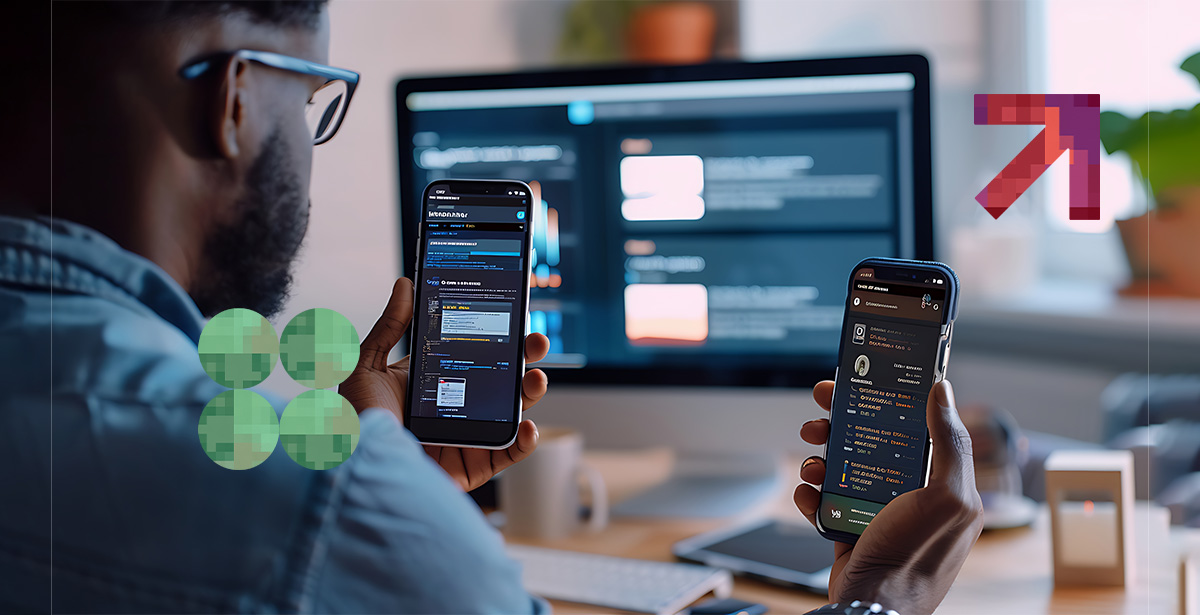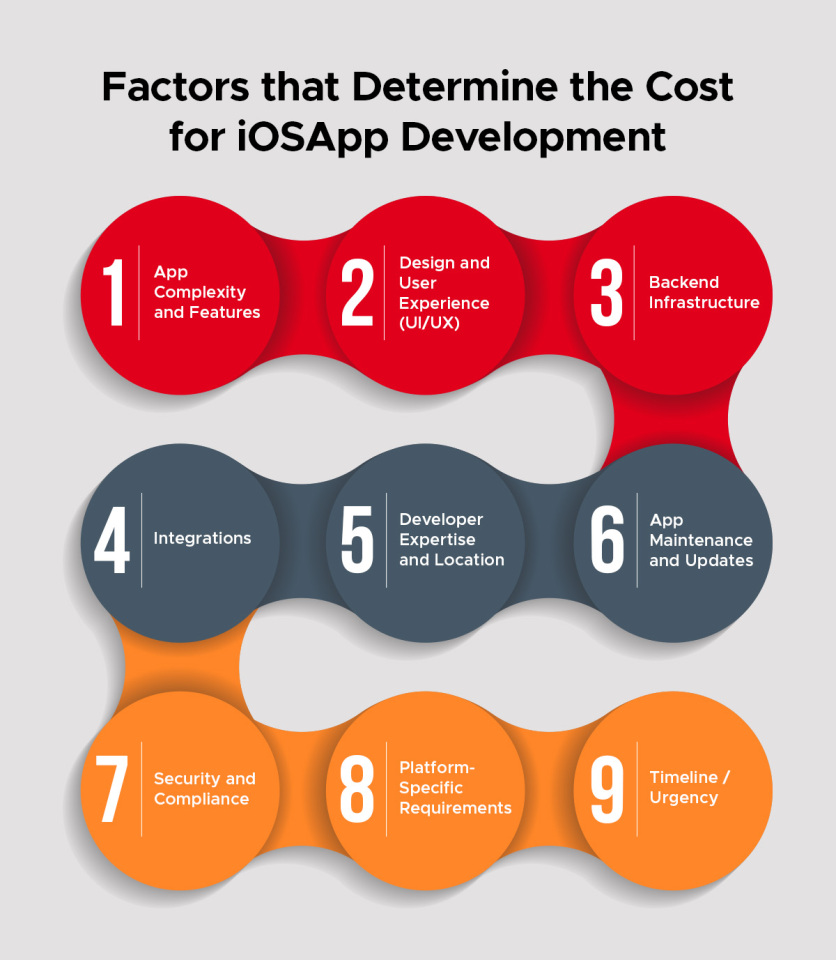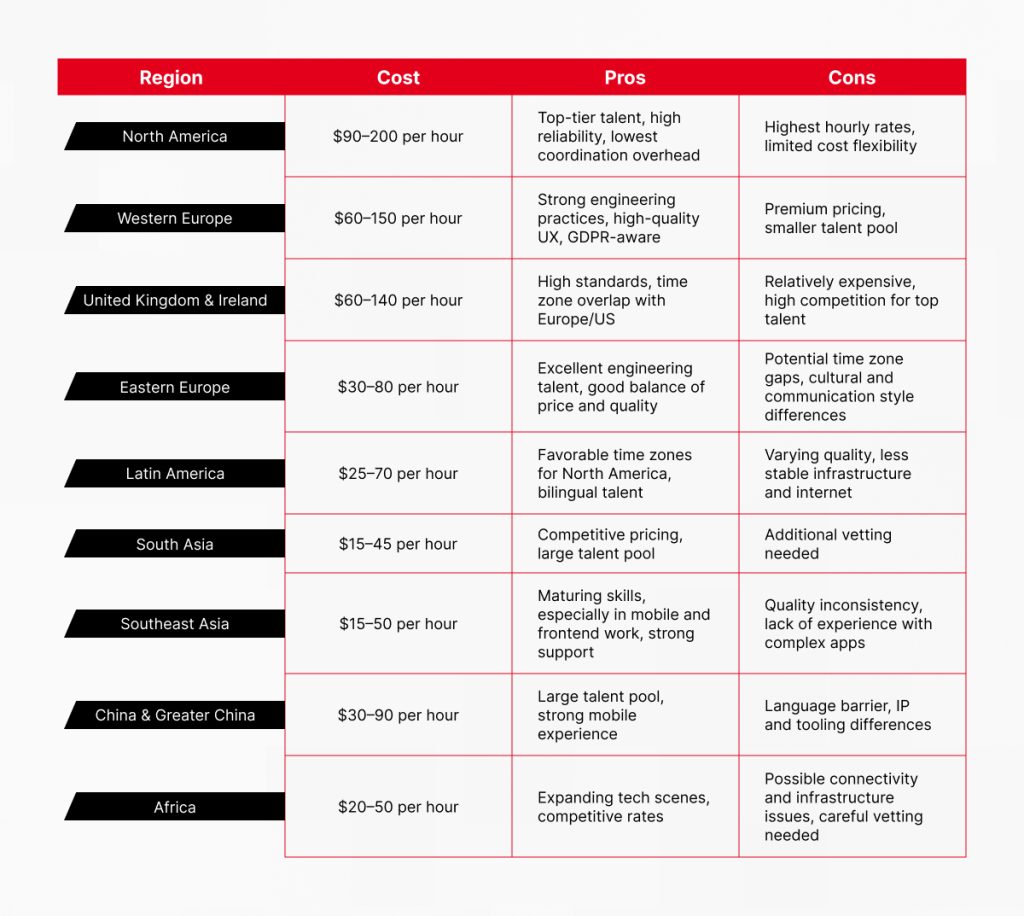9 Factors that Determine iOS App Development Cost

Mobile app development isn’t slowing down anytime soon. In fact, Statista reports it’s bound to reach $756 billion by 2027, with a CAGR of 8.58% from 2022 to 2027. And this demand is fueled by startups and enterprises alike who wish to meet their customers’ needs.
iOS apps are just as popular, with over 2,008,192 apps from 840,720 publishers globally. Not only do they offer secure, high-quality user experiences on Apple devices, but they also leverage Apple’s strong performance and intuitive design.
That way, businesses can effectively create apps that reach premium users, boost engagement, and enhance brand loyalty.
But while you’re tempted to start right away, you’re probably wondering about iOS app development cost. That’s fair really, and the answer is just a few scrolls away.
💡 Still unsure about how mobile apps can grow your business? Custom mobile apps have the power to impact your business, both internally as well as externally. For instance, you can leverage custom app development to automate and streamline processes for your employees, and create apps that collect insights from your customers.
What is the Average Cost to Develop an iPhone App?
The average cost to develop an iPhone app in 2025 starts from $10,000, and can go over $300,000.
A basic/simple app is around $10,000 to $40,000. For this amount, expect a few screens, a simple design, and limited features. This also means no real-time updates or heavy integrations.
Meanwhile, a moderately complex iOS app such as a small e-commerce app or a fitness tracker with reminders costs around $40,000 – $120,000. For this price, expect –
- Standard user accounts, login, or profiles
- Some integrations (payment, maps, push notifications, social sharing)
- More polished UI/UX and ongoing updates
Finally, the iOS app development cost of a highly complex or enterprise app can exceed $300,000. That’s because developers put in a lot of effort and time to deliver –
- Multiple advanced features (e.g. real-time chat, video streaming, AI integration, or heavy data handling)
- Custom backend with scalability in mind
- High security, compliance, and integrations with multiple services
What Affects the Cost for iPhone App Development?
With the TL;DR version out of the way, let’s go into more detail about the factors that go into the development quotes you receive.
There are mainly nine factors that developers base their estimates on:

1) App Complexity and Features
This is the single biggest driver of cost.
Every added feature requires extra design, coding, testing, and often, backend support. The more complex the logic, the higher the hours needed. This will, in turn, be reflected in the app’s budget.
Take for instance a simple calculator app. A basic one with simple functions will take 2-3 weeks, costing you at least $3,000. Meanwhile, an app with extra functions such as support for scientific calculations can cost up to $30,000.
2) Design and User Experience (UI/UX)
The iOS app development cost you’re quoted also takes into consideration the user interface and user experience.
Apple users expect clean, intuitive, and visually engaging apps. A basic design with standard components may be cost-effective. However, if you’re aiming for a polished look that wow users, you need professional UI UX design services.
High-quality animations, custom graphics, and seamless flows demand additional expertise and testing, which naturally adds to the cost.
3) Backend Infrastructure
A number of apps don’t just run on the phone; they rely on servers. Such apps require real-time updates, user data storage, or integrations with multiple systems. In short, you’ll need a robust backend.
Developing APIs, setting up cloud hosting, and ensuring scalability all take time and resources. In other words, the more data your app processes, the bigger the infrastructure investment.
💡 When planning your iOS app, build a scalable backend from the start. Even if you’re launching with minimal features, you need to be ready for the future beforehand. Using cloud services like AWS, Firebase, or Azure can save huge costs later by avoiding complete re-engineering when your user base grows.
4) Integrations
Integrations are crucial for iOS apps because they extend functionality beyond the core code and, ultimately, enable seamless user experiences.
From payments and maps to push notifications and social logins, integrations reduce development time, enhance usability, and meet user expectations. They also ensure apps stay competitive by connecting with trusted third-party services.
Each integration requires not only coding but also compliance with third-party standards and continuous maintenance. And all of this will be reflected in the iOS app development cost you get.
5) The Developer Expertise and Location
Where your development team is located can drastically change the price tag. Here’s a table detailing what you can expect from developers across the world.

Developers’ experience will also play a role in how much you’re charged –
- Junior / Entry: $15–40 per hour
- Mid-level: $30–90 per hour
- Senior / Expert: $80–200+ per hour
If you wish to get the right talent for your project, you’ll need to do a few things, including:
- Specify deliverables (APIs, wireframes, acceptance tests) to compare quotes fairly.
- Interview for relevant experience.
- Ask for code samples and references. You can also check GitHub or published apps.
- Use short paid tests to validate fit before committing long-term.
- Account for non-dev costs such as design, QA, DevOps, and maintenance.
6) App Maintenance and Updates
Maintenance and updates will also contribute to your quoted iOS app development cost.
iOS regularly updates its operating system, and your app must stay compatible. Add to that bug fixes, new features, and user-driven changes, and you’re looking at 15–20% of your original development cost every year just for maintenance.
And if you’re considering ignoring iOS app maintenance, don’t. Doing so will be costly long-term.
Without updates, apps risk crashes, poor performance, and incompatibility with new iOS versions. Plus, security vulnerabilities grow unchecked, user trust declines, and competitors outpace you with better features.
7) Security and Compliance
Security is a major concern for iOS apps. A study by Cybernews revealed that 156,000 apps unveiled hardcoded secrets that could lead to breaches or data leaks.
Unless you want to be part of this statistic, you need to invest in securing your app and ensuring its compliance. Especially if your app handles sensitive data such as financial transactions, or your industry has to meet strict compliance requirements like GDPR.
Implementing data encryption, secure logins, and audit trails requires extra effort, specialized developers, and often, legal consultation. These safeguards are non-negotiable and can considerably increase development costs.
💡Security related errors aren’t the only mistake that can tank your iOS app. There are several custom ios mobile app design and development mistakes that developers make, impacting usability and user experience. So, if you wish to ensure maximum ROI, you should be aware of these and detect them before your app ends up in users’ hands.
8) Platform-Specific Requirements
Apple has a long list of strict requirements that can impact the iOS app development cost.
For instance, Apple requires all iOS apps to meet App Store Review Guidelines, including strict rules on privacy, security, and UI design.
If your app collects user data without transparent permissions or uses non-standard payment systems, it can be rejected. And rejections during the App Store review process mean additional development cycles.
Moreover, optimizing your app for the latest iPhone models, iOS versions, and even supporting older devices adds more complexity to the project. This, in turn, adds to the cost of your app.
9) Timeline / Urgency
If you want your app fast, expect to pay more.
Urgent projects require more developers working in parallel, overtime hours, and often, reduced testing windows. While this accelerates delivery, it can nearly double the cost compared to a standard-paced project.
So, if urgency isn’t a priority, establish a well-planned timeline. That’ll ensure a more cost-efficient build.
How to Save on iOS Application Development Cost
You can absolutely save on iOS app development, but you’ll need smart planning, not cutting corners. If you’re curious about what this entails, here’s what you can do.
Start with a Minimum Viable Product
An MVP is the first, simplified version of an app that includes only its core features. It offers just enough for users to test, give feedback, and validate your idea.
Instead of spending months building a full product, an MVP helps you:
- Test demand before heavy investment
- Identify what users actually want
- Reduce development time and costs
- Pivot quickly based on real feedback
In addition to validating your idea, an MVP prevents you from wasting money on features users don’t need.
Before you think this is a waste of time, you may want to read about how we helped a startup grow into a unicorn by starting the development with an MVP.
iApartments, a leading smart apartment solutions innovator, started its journey with an MVP back in 2019. Since then, our developers have worked closely with its team to expand its offerings, enhancing units’ comfort, convenience, and safety. More in the video below.
Outsource Wisely
Outsourcing can significantly lower your iOS app development cost, but only if done thoughtfully. As tempted as you may be, don’t rush to hire the cheapest option. Quality, reliability, and communication matter just as much as pricing.
Start by thoroughly vetting developers or agencies. Review their portfolios, check client testimonials, and explore past iOS projects to assess design consistency and code quality.
Also, ensure they have clear communication practices like regular updates, transparent billing, and shared project management tools to keep progress visible and expectations aligned.
Don’t Shy Away from Using Pre-Built Solutions and APIs
A smart way to cut iOS app costs is by using pre-built solutions, APIs, and third-party integrations instead of developing every feature from scratch. These ready-made tools can save weeks of development time and thousands of dollars.
For instance, you can integrate Stripe or PayPal for payments, Firebase for authentication and analytics, or Google Maps API for location features. These platforms are well-tested, secure, and constantly updated. And they’re far more reliable than some custom-made solutions.
If you’re worried about sacrificing uniqueness, don’t. You can rely on custom UI and user flow that fit your brand. This approach lets your developers focus on what makes your app different rather than reinventing common functionalities.
Plan Your Features and Scope Clearly
One of the biggest reasons the iOS app development cost tends to spiral is poor planning.
Before writing a single line of code, define what your app must do (core features) and what can wait (nice-to-haves).
That way, you’ll have a well-defined scope that keeps the project focused, prevents costly mid-project changes, and helps developers estimate time and effort accurately.
Choose Agile Development
In case you didn’t already know, Agile is a cost-saving strategy. This approach breaks your app project into small, manageable sprints, allowing for frequent testing, user feedback, and quick adjustments.
Instead of discovering issues late, Agile helps you catch and fix them early, saving time and money. It also ensures you’re always building toward real user needs rather than assumptions.
💡While screening development partners, make sure to determine whether they’re actually Agile or just ‘doing Agile’. Developers doing Agile simply follow rituals such as standups, sprints, and retros. Meanwhile, developers being Agile embrace adaptability: they prioritize collaboration, respond to change, and continuously refine code based on feedback.
Automate Testing and Deployment
Manual testing and deployment can eat up hours of developer time. And there’s always a risk of human errors arising, costing you even more in the long run. B
By using automated testing tools like XCTest, Appium, or Jenkins, you ensure faster, more consistent quality checks.
Similarly, automating deployments through CI/CD pipelines means new versions roll out smoothly with minimal downtime. This, in turn, results in fewer bugs, lower maintenance costs, and faster updates to the App Store.
Need an iOS App Developed?
DPL has more than the experience and expertise you need. We also offer innovation, delivering apps that go beyond your vision to truly stand out.
Let us know how we can help you in the form below.





